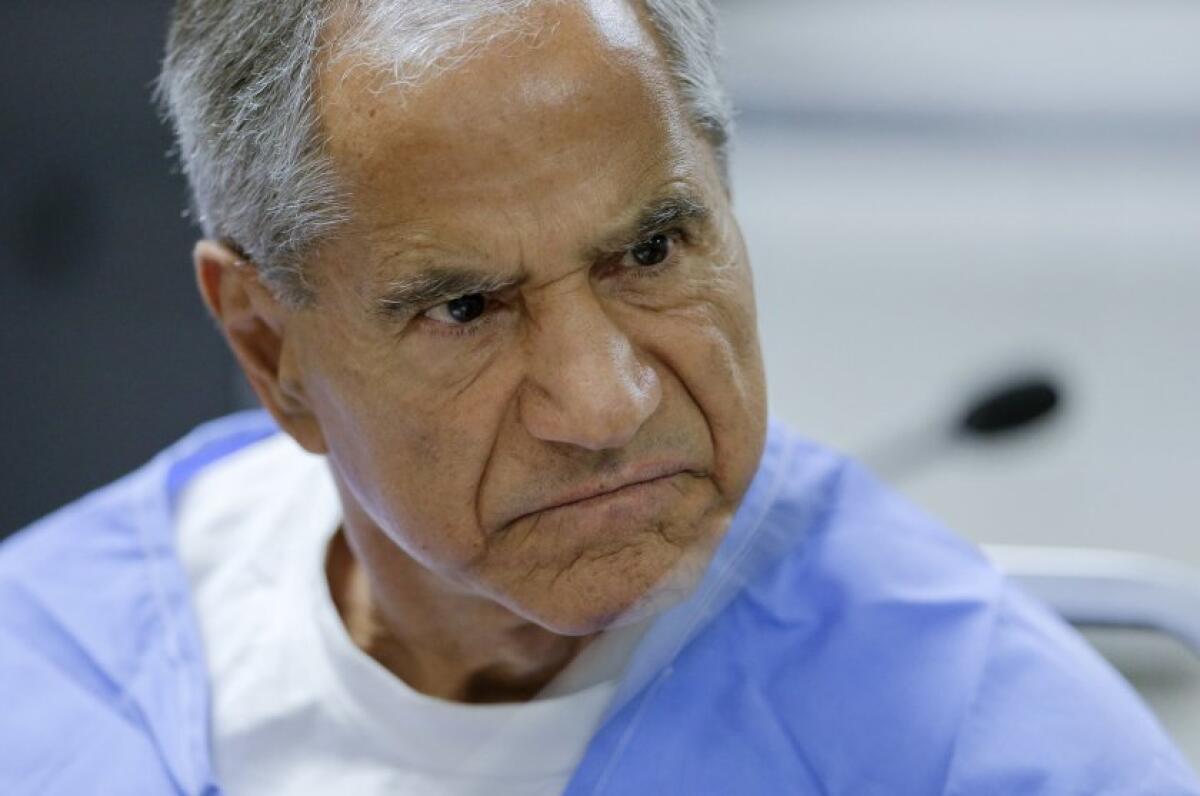Column: Is it time to release Sirhan Sirhan from prison? He’s served 53 years for killing Robert Kennedy
- Share via
Update: On Friday, a California parole board panel recommended parole for Sirhan Sirhan.
Let’s try a thought experiment: What if, instead of going to the Ambassador Hotel on June 5, 1968, and shooting a bullet into the brain of Sen. Robert F. Kennedy, Sirhan Sirhan had gone instead to the nearest McDonald’s and shot the guy behind the grill?
Would he still be in prison today, five decades later?
That question comes up because Sirhan — who is 77 years old and has been in prison for 53 years — is due to appear before a California parole board panel on Friday.
He has been up for parole before — 15 times, in fact. And he’s been rejected every time. The last time, in 2016, the panel concluded that he had not shown adequate remorse.
I can’t read the minds of the parole commissioners. But I can’t help wondering — call me cynical! — whether he was rejected 15 times at least partly because he belongs to a category of criminals, such as Charles Manson and others whose crimes generated huge headlines, who are notorious, and for whom the rest of us harbor a particular level of animosity. In Sirhan’s case, he may even have changed the course of American history, because his victim was a candidate for president.

One of the commissioners acknowledged the relevance of that as he announced the panel’s 2016 decision, saying that Sirhan’s crime “impacted the nation and I dare say it impacted the world.” He called it “an attack on the democratic system.”
But I’m not persuaded that either the notoriety of the crime or its national political implications should be such significant factors in whether Sirhan is paroled.
It seems to me that the parole board should try to determine whether Sirhan meets the usual criteria. Is he remorseful? Does he pose a threat of re-offending or of other violence? Does he have a clean prison record?
But if he meets the requirements any other first-degree murderer would have to meet, the arguments are strong that the board should recommend parole despite the notoriety of his crime.
Why should California continue to hold a prisoner who has served more than 50 years, who has behaved well in prison and who the experts suggest is highly unlikely to kill again — just to keep him in perpetual punishment at great expense to state taxpayers as he ages, requires more costly healthcare and eventually dies?
To be clear, Friday’s panel won’t make the final decision. It is expected to decide only whether Sirhan is suitable for release. If it concludes he is, that recommendation will be reviewed by the full parole board and then sent on to the governor for approval, reversal or any of several other options. The governor, of course, will be keenly aware of the potential political backlash of releasing such an infamous prisoner.
But the fact is that Sirhan appears to satisfy many of the usual grounds for release. Psychological risk assessments have repeatedly deemed him a low risk for violence, according to his lawyer, Angela Berry. He hasn’t been accused of any serious violations of prison rules since 1972.
According to Berry, the parole panel’s job is straightforward: to determine whether offenders are sufficiently rehabilitated to be safely released back into society. Not to re-litigate the case and not, frankly, to decide whether the crime was so grotesque or impactful that the prisoner should rot in prison until he or she dies.
Besides, it’s not clear to me why a headline-grabbing murder is worse than one that is ignored or forgotten. Nor is it immediately obvious that the assassination of a U.S. senator merits a longer sentence than the murder of, say, a young child.
This go-round for Sirhan is getting extra attention partly because for the first time there will be no prosecutors appearing before the board. Traditionally, local district attorneys have fought to ensure that criminals they’ve prosecuted are not released too easily or too early. But L.A.’s new progressive district attorney, George Gascón, has said he will not be sending lawyers to parole hearings to do that.
On balance, that’s the right decision. The prosecutors’ job should not be to make sure criminals they prosecuted 50 years earlier die behind bars. Their job is to seek justice on behalf of the state and all its people up to the time of sentencing. They have little insight into what’s happened to an inmate since the trial.
To be clear, I am not a person who believes we should abolish the prisons. Criminals should be punished for their misdeeds and kept apart from society when they’re dangerous.
But I also believe in mercy and rehabilitation.
Is the 77-year-old Sirhan the same as the 24-year-old man who committed the crime? Supreme Court decisions and California law in recent years have concluded that the youth of an offender at the time a crime is committed should be given “great weight” in parole decisions. Another California law requires “special consideration” in parole decisions for convicts over the age of 50 because their “age, time served and diminished physical condition” may have made them less of a risk for future violence. The parole board should weigh those factors.
One woman who is expected to speak before the parole board is Jen Abreu, who runs a nonprofit called Redemption Row California. She’s looked at a group of other inmates convicted of first-degree murder — many of them gang members she’s worked with — who have been granted parole even though they’ve served less time than Sirhan and been cited for much more serious disciplinary infractions. Some of them stabbed other inmates or assaulted guards but were released anyway. Abreu says Sirhan is one of California’s longest-serving inmates.
Public safety, remorse, mercy and pragmatism are among the factors that ought to play into the decision whether or not to release Sirhan. Big blaring headlines and political fallout should not.
More to Read
A cure for the common opinion
Get thought-provoking perspectives with our weekly newsletter.
You may occasionally receive promotional content from the Los Angeles Times.











